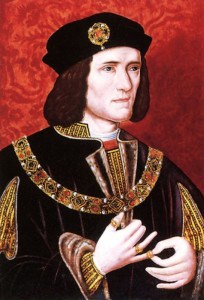Richard III and the Lessons of Leicester
By Cy Smith, Vice President of the Board of Trustees
Now is the winter of our discontent
Made glorious summer

Portrait of Richard III
If you’re a history buff like me, you’ve doubtless followed the story of the exhumation of the remains of Richard III, England’s most maligned king. The story of Richard in brief: A dynastic struggle in England between the Plantagenet and Tudor families culminated in a Tudor victory at the battle of Bosworth Field, near Leicester, in 1485. Richard III, the last Plantagenet king, was slain by the forces of Henry VII. Tradition has it that his body was displayed in Leicester for two days and then thrown into the River Soar.Politics was literally a blood sport in the fifteenth century. Richard was immortalized by Shakespeare, who portrays a malevolent prince, one of the most villainous characters in literature. The extent to which Shakespeare’s portrait is historically accurate, or a reflection of Tudor ascendancy, remains a matter of debate. While Shakespeare’s Richard is very much alive in our culture, the Richard of history has been somewhat obscured. Recent developments show his historical stock to be on the rise.
The reemergence of the historical Richard is due to the unique partnership of an historical society, a city council, and a university. The historical society is a specialized one – the Richard III Society. Under the leadership of a dedicated Ricardian, Philippa Langley, the Society uncovered archival evidence that the body of Richard had in fact been buried at Greyfriars Abbey in Leicester. Like many religious institutions seized by Henry VIII, the abbey fell into disuse in the sixteenth century. Eventually it was torn down and its exact location was not recorded. The Society persuaded the Leicester City Council and the University of Leicester to join in the search and was instrumental in raising approximately $250000 in contributions for the project. With the assistance of ground-penetrating radar, archaeologists located the site under a parking lot in downtown Leicester. Excavation followed and last fall a skeleton bearing the marks of a battlefield death and having a deformed spine (“rudely stamped”, as Shakespeare says) was unearthed. DNA tests with two known descendants of Richard’s sister led to a scientific conclusion that the remains were those of the king. Now plans are afoot for a reburial in Leicester Cathedral. York, where Richard spent his youth, has put in a competing claim for reburial but Leicester’s precedence has been upheld by England’s Justice Minister. Leicesterplans the establishment of a visitor center chronicling the life of Richard III and has already opened a temporary exhibit. In the meantime the parking lot has become a popular tourist attraction.
What lessons can we at Geneva Historical Society draw from this? The first is obvious: History is everywhere, even underfoot. Even more important, history requires dedicated people to recreate it. The recreation is an ongoing process, drawing upon archives and other records of the past. History exists in our minds, but the physical manifestations of it – its corporeal substance, if you will – bring it wider public attention. History is important for a community: it is fundamental to creating an identity. And finally, history like any other non-profit endeavor requires a public willing to support it.
